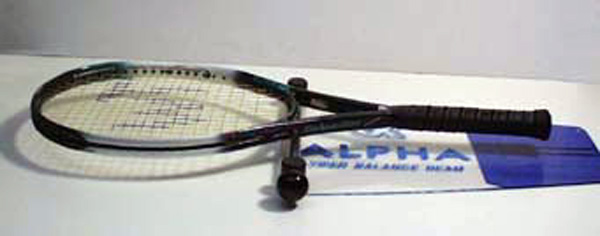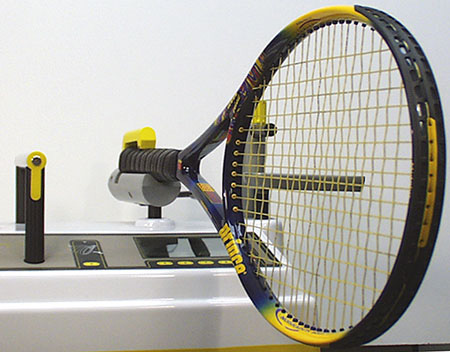Weight
Weight is the resistance to movement in a straight line. Lifting is an example. The racquet resists (does not move) your lifting efforts until you pull with a force equal to its weight. Then you can lift it. Weight is what you feel if you pick the racquet up by the tip or handle while allowing the opposite end to hang straight down to the ground. Weight is also what you feel if you pick the racquet up at the balance point. Weight influences balance and swingweight, but by itself, pure and simple, it is rarely what the player is directly experiencing when interacting with the racquet.
Balance
The balance point of a racquet is that point along the length of the racquet where a racquet will teeter and totter on a thin support (like a 1/2" dowel or the edge of a ruler) without one end or the other being pulled to the ground. If the racquet balances halfway up the racquet from the butt, it is said to have even balance. If the balance location is more than half way up the racquet, it is said to be "head-heavy," because the shorter head "half" counter-balances the longer handle "half." Finally, if the balance location is less than half way, the racquet is said to be "head-light" because now the head-side "half" is longer and counter-balances the shorter handle-end of the racquet.

Unfortunately, "head-light" or "head-heavy" does not actually mean one end is lighter or heavier than the other, but just that the mass of the materials is spread out in such a manner that the short side of the balancing racquet behaves heavier. The way it works is that a smaller bit of weight at a great distance from the balance will counter balance a bigger bit of mass at a lesser distance from the balance point.
What is important to know about balance is that the racquet behaves as if all the mass were located at the balance point. That is why it is also sometimes called the center of mass. For equal weight racquets, the closer the balance point (center of mass) is to your hand, the less force (torque) you need to hold the racquet up horizontal to the ground (holding at the handle).
Swingweight
Much of a tennis hit can be seen as a battle between the player and the ball to move the racquet in a circle. Swingweight is the resistance to movement in a circle. Circular motion (as in most stages of a tennis swing) occurs around a center or rotation, let's say the butt end of the handle. When you apply equal forces to the handles of two racquets with different swingweights, the racquet with the higher swingweight will accelerate less and rotate less quickly around the center of the circle. The lower swingweight racquet will accelerate more quickly. In other words, higher swingweight means less maneuverability, and lower swingweight means more.

But the ball applies a force to the racquet also. And the same principle applies. The lower the swingweight, the more easily the the ball will move the racquet, and the higher the swingweight, the less easily the ball will change the motion of the racquet.
So the tradeoff becomes this: lower swingweight results in greater racquet acceleration and final swing speed, but more shock (due both to more racquet deceleration by the ball and higher impact force due to greater speed). Higher swingweight results in slower racquet acceleration and final swing speed but less shock due to less deceleration due to the ball pushing the racquet in an opposite circular rotation.
Power is influenced also. With a lower swingweight, the power must be generated more from swing speed. With a higher swingweight, more of the power comes from the racquet itself.
The beauty of customization is that you can easily experiment and find the best tradeoff for your style of play.

